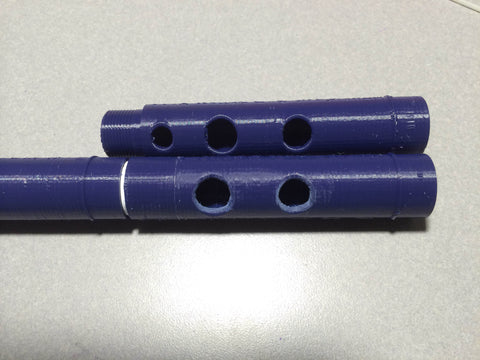The Qwistle
|
The Qwistle was design during May & June of 2014. Initially based on a previous design, the "Paper Whistle" (also featured on this site), the Qwistle was designed specifically to be printed using FFF (Fused Filament Fabrication) printers, specifically those deriving from the RepRap project, and becoming common as affordable (and often home-built) 'desktop' 3D printers around the world. The impetus for the development of the Qwistle was provided by the success of the "Dreaming Pipes" project, which ran on Kickstarter during March & April 2014. A "penny whistle" STL kit was one of the rewards offered, and was initially intended simply to be an FFF-friendly version of the existing Paper Whistle. As with so many other aspects of "Dreaming Pipes", however, the opportunity to develop something really special was clear. The whistle would be distributed to (and thus hopefully test-printed by) the majority of backers, and a great deal could therefore be learnt relevant to the development of musical instruments intended for 3D printing. The simplicity of the penny whistle, combined with the demanding nature of the traditional music that can be played on it, made it a good candidate for this kind of experimentation, and a substantial amount of time and effort was thus devoted in the early stages of the project to designing and prototyping what it was hoped would be a professional-grade instrument. |
Four early copies of the Qwistle, printed for "Dreaming Pipes" backers |
|
A laser-sintered & dyed Qwistle on display, 3D Printshow London 2014 |
As with all of the "Dreaming Pipes" STL kits, it was decided to make the Qwistle kit modular. The reason for this decision, was to allow the size of the parts to be restricted to a size suitable for even the smallest (and therefore the cheapest) of printers. The Printrbot Simple, which was at that time available fully assembled in the UK for between £300-£400, and has a z-limit of about 100mm, was used as the benchmark. The Orion and Ultimaker 2 printers being used for development are both capable of more than double that z-height, however accessibility was to be a key requirement for all of the "Dreaming Pipes" kits, and both the Orion & Ultimaker are substantially more expensive printers. Parts were also split where required, to provide better tone in the finished instrument. The fipple in particular was divided, to allow all the parts to be printed without support - the surface damage caused by support can spoil the tone, or even de-voice the whistle altogether. A tuning slide was also provided, to allow fine pitch control. |
| In producing an instrument as a file set, intended for 3D printing, one of the greatest challenges is to design a file set that will produce a good quality instrument on as wide a range of machines as possible. The "Dreaming Pipes" file set projects have provided a perfect opportunity to experiment with this process, and various approaches have been tried along the way. In the case of the Qwistle, the file set was designed to work "off printer" with the minimum of finishing. All joints are thread-sealed in the manner of the bagpipes, with the recommended material being PTFE tape, readily available from plumbers merchants everywhere and which produces an airtight renewable seal. The exception is the fipple-mouthpiece joint, which has to be glued with a suitable gap-filling adhesive. Two aspects of the whistle in particular are vulnerable to variations in print quality - the first is scale temperament, which is affected particularly if the finger holes print off-round. The second is tone & voicing, which can be affected by any roughness or flash in the mouthpiece or fipple area. Both of these problems can be easily corrected by well established whistle "tweaking" techniques however. |
"Dreaming Pipes" backer Bill Owens' Qwistle-derived tabor pipe |
|
Qwistles in a range of sizes and keys. The leftmost & smallest Qwistle has a customised scale, and was printed specifically to play "Hurricane Brown" with Alasdair Roberts, at the Glad Cafe in Glasgow |
This reliance on hand-finishing means (happily, I think), that although I originally set out to provide a penny whistle with a sweet, focused tone, moderate volume (stronger than the Paper Whistle), clear but sweet bottom hand, easy octave crossing, sweet high notes and a well-tempered scale throughout - in actual fact, armed with the STL set, a 3D printer, some fine sandpaper and a working knowledge of whistle-tweaking, it's actually possible to produce just about any sort of whistle sound the player might want. If the whistler also has a working knowledge of CAD, then the modular nature of the Qwistle will allow for adaptations to the design of any part, mouthpiece, wind way, body, that the player would like to alter. The potential for customisation has already been used to good effect on a number of occasions, most notably by "Dreaming Pipes" backer Bill Owens, who has created an entirely new instrument in the form of a Qwistle-derived tabor pipe. Custom Qwistles have been created in a number of pitches, keys and even bore sizes. Those pictured include wide-bore Bb and A Qwistles (with a flute-like tone), along with a whistle customised specifically to provide a scale suitable for Alasdair Roberts' song "Hurricane Brown", which was played at a performance in the Glad Cafe, Glasgow in 2015. |



